Contents
In winter, the lack of fresh food and vitamins is especially felt. You can fill it with the help of foreign fruits and vegetables, the cost of which, as a rule, is quite high. Do-it-yourself greens grown on the windowsill can become an alternative to purchased fresh products. The technology of cultivating greenery at room conditions is quite simple and accessible to every owner. You can grow any greens on the windowsill, which will become an ornament and a flavoring “highlight” of many dishes, a fresh source of vitamins and minerals. Below in the article we will talk about how to grow greens on the windowsill in winter without problems and hassle.

What greens are suitable for growing on the windowsill
More often in winter, spicy herbs are grown in the apartment, such as parsley, dill, thyme, basil, cilantro or lemon balm. Also in demand in the winter are leafy lettuces, spinach, onion feathers. Each culture is distinguished by its agrotechnical requirements for growing conditions, therefore, deciding to cultivate this or that greenery on the windowsill, you need to know and remember the following features:
parsley
You can grow parsley on a window in winter from the seeds or root of this plant. For growing from seeds, parsley varieties such as Astra, Vorozheya, Sugar, Harvest, and Beads are chosen. Before sowing, seeds are recommended to be prepared by soaking. To do this, they are wrapped in a cloth or gauze bag, moistened with warm water, placed in a plastic bag, leaving the bundle in conditions with a temperature of + 23- + 250From for a day. After that, the grains are sown in a container filled with fertile soil to a depth of 5 mm. Before the appearance of sprouts, the container can be placed in a dark place, but as soon as the first shoots appear, the container with greens is placed on the windowsill.

The process of growing parsley from seeds is quite long: from the day of sowing the grains to the first tasting of greens, about 1,5 months should pass. By this time, the greens will have a height of 8-10 cm.
To do this, choose rhizomes with a diameter of 2 cm and a length of less than 5 cm. Such short and plump roots must necessarily have an apical bud. The roots should be planted in a deep container under a slope so that a layer of soil of 2-3 cm can be poured over their uppermost part. After planting the roots, the container should be installed in a cool place, and with the appearance of sprouts, place it on the windowsill. The optimal temperature for green growth is the range from +15 to +200C.
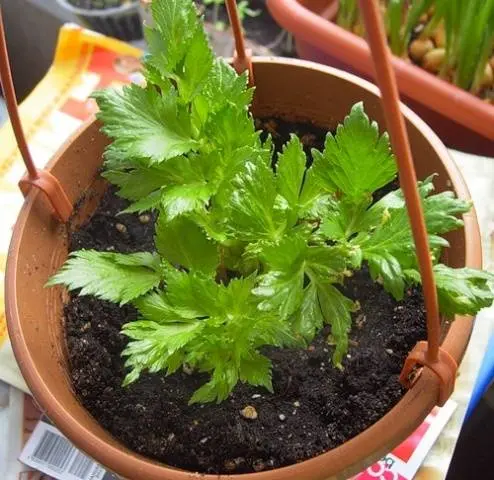
Fennel greens
Dill can be used in the preparation of many dishes. Such popularity makes dill one of the most sought-after crops on the windowsill in winter. For cultivation in room conditions, the varieties “Grenadier”, “Gribovsky”, “Uzbeksky-243” and some others are used.
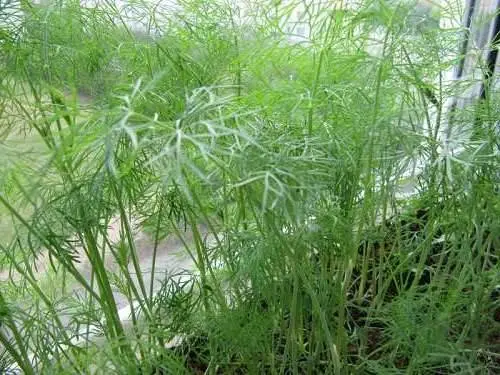
Before sowing, green seeds are disinfected with a manganese solution and soaked for a day in warm water, changing the liquid every 6 hours. Sow seeds in a container filled with light nutrient soil. To do this, furrows are made at a distance of 10-15 cm. Seeds in the furrows are sprinkled with a layer of soil, 1-2 cm thick.0C. Under such conditions, dill sprouts in a week, and fresh herbs, in full, can be eaten in a month.
thyme greens
Growing thyme on a windowsill in winter is very easy. To do this, prepare a deep and spacious container. A drainage layer is poured at its bottom, on top of which fertile soil is placed. Thyme seeds are embedded in the soil to a depth of 1-2 cm. It is necessary to moisten the soil as it dries. Before the emergence of green shoots, the containers are placed in a dark and warm corner. After the germination of greenery, they are installed on the windowsill. Strongly thickened plantings should be gradually thinned out.
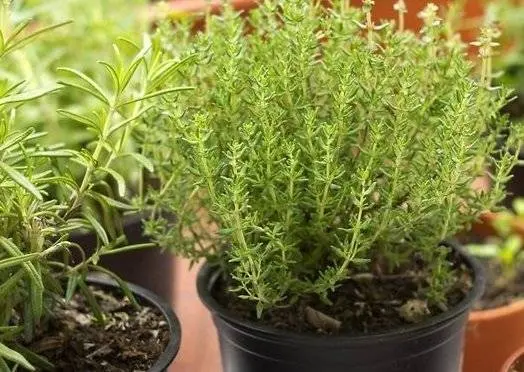
green basil
Growing basil greens at home from seeds is quite difficult. This is due to the peculiarities of culture:
- basil seeds contain a lot of essential oils, which is why they germinate for a very long time;
- the culture is thermophilic and for the successful growth of its greenery it is necessary to maintain a temperature of the order of +250C.
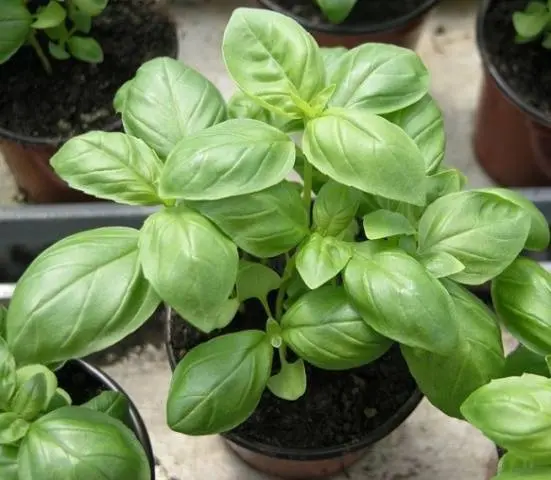
If, given these features, it is nevertheless decided to grow basil from seeds, then it is recommended to soak them in warm water for 2 days before sowing. The water must be changed regularly. For sowing, seeds are scattered on the surface of the soil and lightly covered with a thin layer of earth on top. The container with crops is covered with polyethylene or glass and placed on the windowsill on the south side. As soon as the growth of basil appears, the covering material is removed. When 5-6 leaves appear, the plants are pinched in order to get more side greens. When buds appear, cut them off. It is necessary to moisten the soil in which basil grows daily in the morning.
green cilantro (coriander)
Cilantro is valued for its deep and bright aroma, tender leaves. Having decided to grow this greenery at home, you need to pay attention to the varieties “Ray”, “Amber” and “Change”. It is these varieties that are suitable for growing greens in the winter on the windowsill.
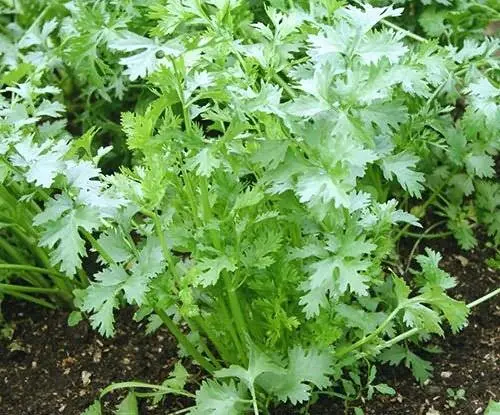
Before sowing in the ground, cilantro seeds should be germinated in a damp cloth or sawdust. The best temperature for seed germination is +17-+200C. As soon as sprouts appear on the cilantro seeds, they must be sown in moist soil, sprinkled with a layer of earth. It is not recommended to sow the seeds of this greenery too densely. The optimal distance from one seed to another should be at least 5 cm. After sowing the seeds, the container should be covered with a protective material that will maintain the required level of moisture for the plants. Every day, the shelter must be removed for a while in order for the crops to ventilate.
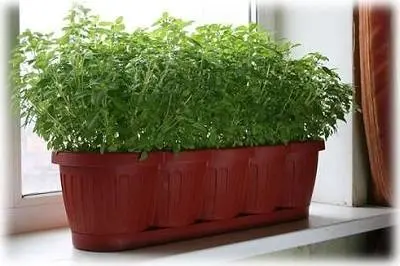
Cilantro grows well at a temperature of +10-+120C. In an apartment in winter, such conditions can be found on an insulated balcony. Within a month from the day of sowing the seeds, cilantro will please with an abundance of green leaves. They must be pinched off and in no case cut off the stems completely, as this leads to the death of the plant.
Melissa
The fragrant greens of lemon balm can be obtained not only in the summer, by growing a plant in the garden, but also in winter, growing it on the windowsill. Melissa is very unpretentious, grows at elevated and low air temperatures, in sunny areas and in partial shade.
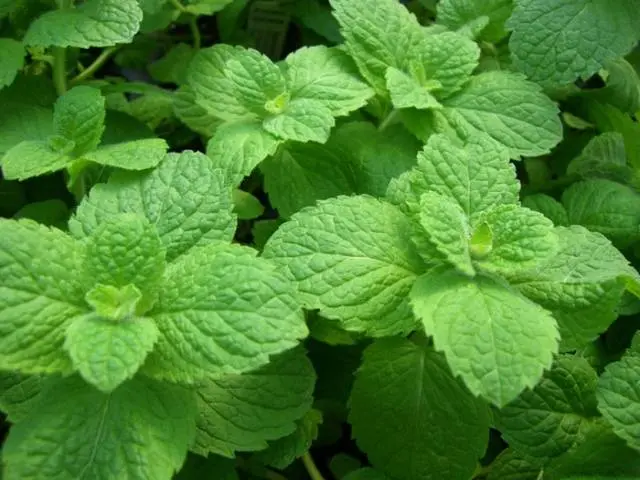
Greens can be grown on the windowsill from cuttings, branches, lemon balm seeds. The easiest way to get this plant at home is to dig it out of the garden with the advent of autumn and plant it in a pot.
Growing fragrant melissa from seeds is a laborious and painstaking task. To do this, the seeds are pre-treated with a solution of potassium permanganate, after which they are sown in a container with fertile soil to a depth of 1 cm. The container must be covered with a film or glass. Young plants from a common pot dive into separate containers. It is important to ensure regular watering and spraying of leaves for lemon balm, while the soil must have good water permeability. By analogy with lemon balm at home, you can grow sage on the windowsill.

Spinach
Spinach can be successfully grown at home in winter on a windowsill in flower pots or other containers, more than 15 cm deep. Before sowing, spinach seeds are soaked in warm water for two days and treated with a manganese solution. They are sown in the soil to a depth of 1-2 cm. The distance between adjacent spinach grains during sowing should be at least 4 cm.
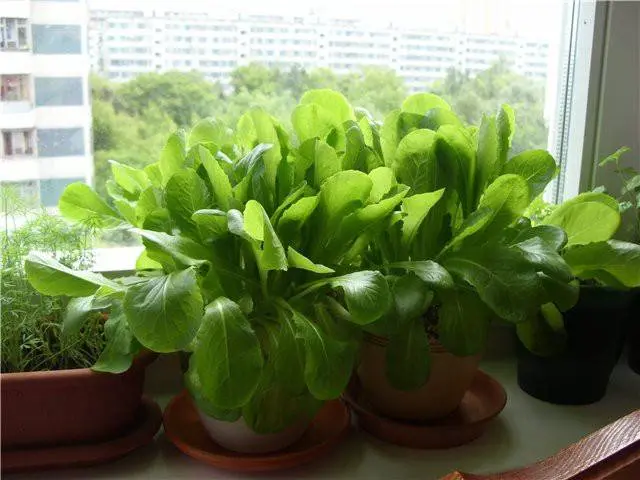
Spinach prefers to grow in sunny areas of the earth at temperatures up to +180C. In conditions of short daylight hours, the growing temperature should be reduced to + 10- + 150C. Water and spray the greens regularly. 3 weeks after sowing the grains in the ground, spinach can be cut for consumption, and seeds can be sprinkled into the remaining containers for the next cycle of growing greens.
Salad leaves
Leaf lettuce is light-loving, so it is recommended to grow it only on windowsills oriented to the south. Otherwise, you will have to regularly highlight the greens with fluorescent lamps. However, it is worth remembering that some special varieties of lettuce can successfully grow in partial shade, for example, Snowflake, Vitamin, Zorepad, Lollo, Raspberry Ball. These varieties of lettuce allow you to get greens in winter on any windowsill without much hassle.

Growing greens on the windowsill in winter can be done using lettuce seeds. They are sown in previously prepared loose and nutritious soil. The container should be deep enough and spacious. After filling the container with soil, you need to make grooves up to 1 cm deep. Rows of lettuce should not be placed too close one to one. The optimal distance between them is 10-15 cm. Before germination, the salad is covered with a film or glass to obtain a greenhouse effect. When the first sprouts appear, the shelter is removed. Thin out the lettuce as it grows.
Onion feather
Onion feather is the best greens on the windowsill in winter for beginner gardeners. If desired, even a schoolboy can grow it.
You can grow a green bunch of onions without soil at all, in water. To do this, fill a small container with liquid. The onion is scalded with boiling water and cut off. The upper part of the plant is to be removed. Only the roots of the onion are lowered into the water to prevent its decay. The greens of such an onion can be cut regularly until the quality of the bulb itself deteriorates (it will wrinkle over time).
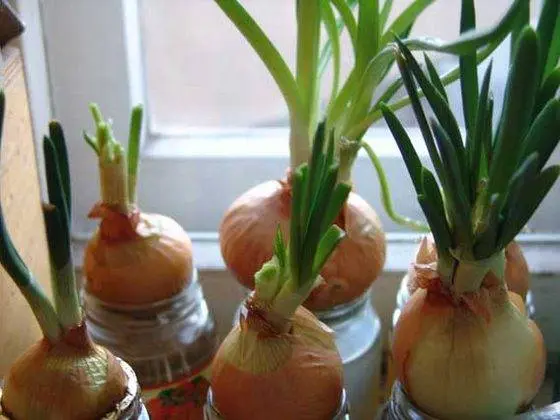
A more difficult way to grow a bulbous feather on a windowsill is to use soil. To do this, fill a small container with a nutrient substrate and drop the bulb into it, immersing it by a third. The plant is regularly watered. Additionally, you can save moisture in the soil by adding hydrogel to the soil mixture when planting onions.
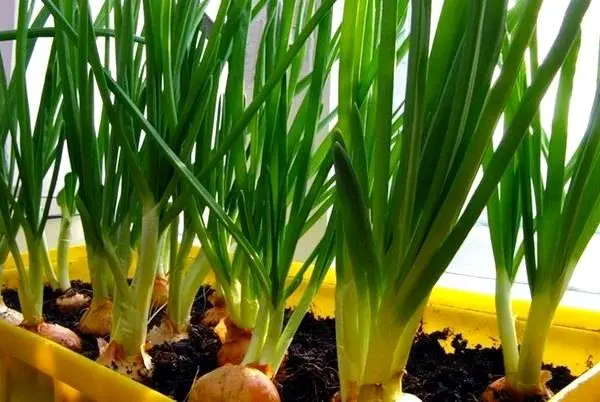
Thus, the question “What greens can be grown at home on the windowsill?” has an unequivocal answer: “Any!”. The list of possible options is not limited to the plants listed above. If desired, you can grow garlic feathers, watercress, chives, oregano, mustard and other crops on the windowsill. At the same time, it is necessary to choose a particular plant based on existing conditions: temperature, light, humidity.
Important rules for growing greens on the windowsill
When deciding to grow greens on the windowsill, it is important to remember some important principles and rules:
- The soil for growing greenery on the windowsill should be light, well-drained. Ideal for use is a mixture of biohumus with coconut fiber. The proportion of the mixture should be 1:2. Soil from the garden before use is recommended to be disinfected.
- Expanded clay, broken brick or pebbles can be used to create a drainage layer. The thickness of the layer in the container must be at least 2 cm.
- The container must have drainage holes.
- It is better to water the greenery at home with a fine spray. Once every 2-3 weeks, liquid complex mineral fertilizers should be added to the water for irrigation.
- To illuminate the greenery, only fluorescent lamps are used. Ordinary table lamps emit a lot of heat and little light.
- It is recommended to grow on the windowsill undersized, bushy, early plants;
- It is necessary to germinate green seeds in early autumn, when daylight hours differ in length. Heat and light will help seedlings germinate faster.
- Light day for most green plants should be 10-13 hours. To illuminate the lamps above the plants, they are placed at a height of 10-50 cm.
- For a uniform increase in the green mass of the plant on the windowsill, it is recommended to turn 1800 once a day.
- To feed the greenery on the windowsill, you can use complexes of mineral fertilizers. Organics in an apartment can become a source of unpleasant odors.
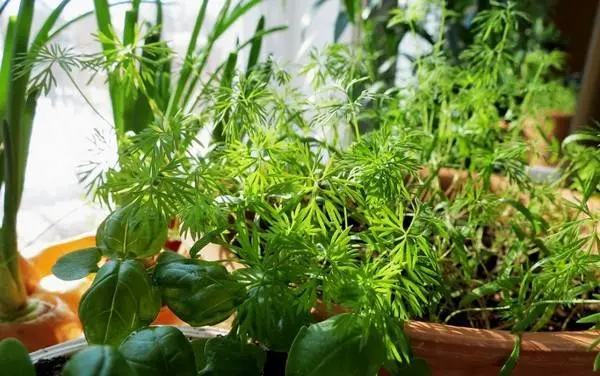
You can get acquainted with some other rules for growing greens on the windowsill in the video:
The video clearly demonstrates the process of growing various greens and allows you to hear valuable comments from an experienced gardener.
To sum up
Growing greenery in winter is, of course, troublesome, but no less pleasant. Indeed, at a time when nature is resting under the cover of snow, wonderful green leaves and twigs grow on a small bed in the apartment, which contain many vitamins and minerals. Using them for food is, first of all, a manifestation of care for your family and friends. The gardener himself, taking care of green plantings, enjoys recalling warm summer days with nostalgia.










